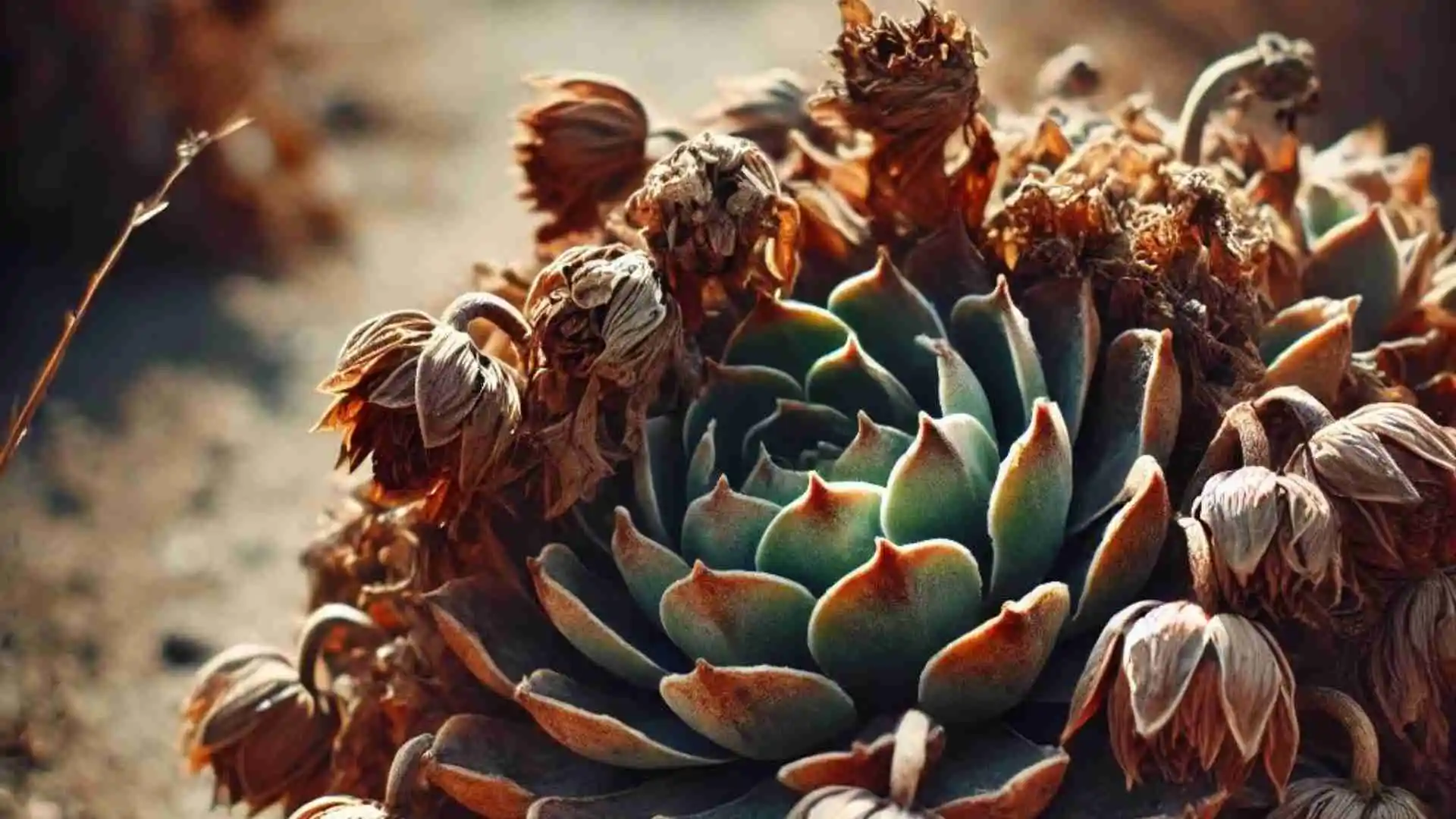Succulents are beloved houseplants known for their unique appearance and ability to thrive in various environments. One common question that succulent enthusiasts often ask is whether these plants die after flowering.
In this article, we will explore the life cycle of succulents, debunk myths surrounding their post-flowering fate, discuss the impact of flowering on their health, examine different types of succulents and their flowering patterns, provide tips for post-flowering care, and delve into the art of propagating new plants from flowered succulents.
Understanding the Life Cycle of Succulents
Like all plants, succulents go through distinct growth stages in their life cycle. Understanding these stages can help us comprehend the intricacies of their blooming and the impact of flowering on their overall well-being.
At the core of a succulent's life cycle are three primary growth stages: germination, vegetative growth, and flowering.
Growth Stages of Succulents
During germination, succulents emerge from their seeds and develop their initial sets of leaves. This period is crucial as it lays the foundation for their future growth.
As the tiny seedling breaks through the surface of the soil, it is a moment of triumph. The succulent's delicate leaves unfurl, stretching toward the sunlight. With each passing day, the seedling gains strength, absorbing nutrients from the soil and water from its surroundings. It is a time of vulnerability and resilience as the young succulent adapts to its new environment.
In the vegetative growth stage, succulents establish their root systems and increase their foliage. This is when they develop their iconic rosettes or stem structures, storing water to survive in arid conditions.
The root system of a succulent is a marvel of nature. It spreads out beneath the soil, anchoring the plant firmly in place. The roots have a unique ability to absorb moisture from the ground, allowing the succulent to thrive even in the harshest environments. As the succulent grows, its foliage expands, forming intricate patterns and textures that are a testament to its adaptability.
Finally, the flowering stage arrives, marking a significant milestone in a succulent's life cycle. During this stage, the plant produces flowers, showcasing its beauty and attracting pollinators.
Imagine a succulent in full bloom, its vibrant petals reaching toward the sky. The flowers come in various colors, from delicate pastels to bold and vibrant hues. Bees and butterflies are drawn to the succulent's nectar, pollinating the flowers and ensuring the continuation of its species. The sight of a flowering succulent is a true marvel of nature's artistry.
Contrary to popular belief, the flowering stage does not spell the end for succulents. While some plants may die after flowering, this is not the case for most succulents.
After the flowers have withered away, the succulent enters a rest period. It conserves its energy, directing it towards growth and maintenance rather than reproduction. The plant strengthens its roots and foliage, preparing for the next growth cycle. With proper care and attention, a succulent can continue to thrive for many years, bringing beauty and joy to its surroundings.

The Truth About Succulents and Flowering
There is a prevalent myth that succulents die after flowering. This misconception has caused concern among succulent enthusiasts, leading them to believe their beloved plants are destined for an untimely demise.
The Myth of Succulent Death Post-Flowering
While it is true that some individual plants may die after flowering, this is not a guarantee for all succulents. The lifespan of a succulent depends on various factors, such as the species, growing conditions, and overall health.
Certain species, typically monocarpic succulents, indeed perish after blooming as they put all their energy into producing flowers and seeds. However, the majority of succulents, especially those commonly found in gardens and indoor settings, are not monocarpic and can continue to thrive after flowering.
How Flowering Affects Succulent Health
Rather than being detrimental, flowering can have a positive impact on a succulent's overall health. The process of producing flowers stimulates the plant's growth and development, leading to stronger, more vibrant foliage.
During flowering, succulents go through physiological changes that enhance their resilience. They invest energy into producing flowers, attracting pollinators, and ensuring the continuation of their species through seed production. This contributes to their long-term survival and health.
Flowering succulents often display robust growth patterns and increased vitality, contrary to the notion of imminent death.
Types of Succulents and Their Flowering Patterns
Succulents come in a wide range of species, each with its own unique flowering patterns. Understanding these patterns can help you plan your succulent collection and anticipate the blooming cycles of your plants.
Common Succulents and Their Blooming Seasons
A variety of popular succulents are known for their stunning blooms. For example, Aloe vera, which typically flowers in spring or early summer, produces vibrant orange or yellow spikes that attract hummingbirds.
The echeveria, another beloved succulent, tends to bloom in summer, showcasing delicate flowers in beautiful shades of pink, red, or yellow.
Moreover, the Haworthia genus offers succulents that often bloom in late winter or spring, boasting clusters of small, tubular flowers in white or pink hues.
You can create a garden that delights with continuous bursts of color throughout the year by acquainting yourself with the blooming seasons of different succulent species.
Succulents with Unique Flowering Behaviors
Some succulents exhibit peculiar flowering behaviors that capture the imagination of plant enthusiasts. One such example is the Agave americana, also known as the century plant.
The Agave americana has earned its name from an interesting characteristic – it typically takes several years, often between 10 and 30, to produce flowers. Once it does, however, the plant enters its final stage of life, focusing all its reserves into a remarkable flowering spectacle.
Other succulents, like the Kalanchoe species, can produce multiple flowers on a single stalk, creating stunning displays of color and texture.
Observing these unique flowering behaviors can enrich your succulent journey, making each bloom a captivating event.
Caring for Your Succulent Post-Flowering
After your succulent has finished its flowering stage, it requires specific care to ensure its ongoing health and vigor.
Watering and Feeding After Flowering
Once the flowering stage concludes, it is essential to adjust your watering routine. Succulents typically prefer drier conditions, so reduce the frequency of watering but maintain sufficient hydration for the plant's needs.
Observe your succulent's response to watering, as each species may have different requirements. Focus on providing water as the soil dries out, allowing the roots to absorb moisture without becoming waterlogged.
Additionally, consider providing a balanced fertilizer formulated for succulents to support their nutritional needs. This can help replenish any nutrients that may have been depleted during the flowering period.
Pruning and Maintenance for Flowered Succulents
Pruning can be beneficial for succulents, particularly after flowering. Remove any faded or withered flower stalks and trim back leggy growth to encourage compact and balanced plant development.
Inspect your succulent for signs of disease or pest infestation, as flowering can sometimes put additional stress on the plant, making it more susceptible to such issues. Address any problems promptly to safeguard the health of your succulent.
Propagation from Flowering Succulents
As succulents flourish and produce flowers, they also provide an opportunity for propagation, allowing you to expand your collection and share the joy of these remarkable plants with others.
How to Harvest Seeds from Succulent Flowers
Harvesting seeds from succulent flowers requires patience and attention to detail. Allow the flowers to finish blooming and develop seed pods. Once the pods are fully ripe and begin to split, carefully collect the seeds and store them in a dry and cool place.
Propagating New Plants from Flowered Succulents
Another method of propagation involves taking cuttings from your flowered succulents. Select healthy stems with several sets of leaves and let them dry and callus over for a few days. Once calloused, plant the cuttings in well-draining soil, and with proper care, they will develop roots and grow into new plants.
By successfully propagating from flowered succulents, you can extend the legacy of these beautiful plants and expand your indoor or outdoor garden with unique specimens.
What We Learned
succulents do not necessarily die after flowering. Flowering is an essential part of a succulent's life cycle, contributing to its overall health and vitality. Understanding the unique flowering behaviors of different succulent species allows you to appreciate their beauty and plan for their care accordingly. With mindful post-flowering care and the art of propagation, you can cultivate a thriving succulent collection that provides joy and fascination for years to come.
Succulent Care For Beginners or Advanced Succulents are a popular choice for those with green thumbs and aspiring gardeners alike. They have the power to change your living room aesthetic, aside from being both beautiful and hardy.Whether you’ve just stumbled onto this article, have been given a succulent as a
How to plant succulents outdoorsAre you thinking of growing succulent plants outdoors? Then you need to consider various factors, the environmental conditions being the most critical one. In this guide, you will learn all about growing and caring for succulent plants in outdoor conditions.What are succulent plants?Succulent plants are those
Growing Succulent Plants Indoors : What We Recommend Love Succulent plants? We don’t blame you! They make an ornamental addition to any home space.But learning how to care for succulent plant indoors can be tricky. They come in endless colors, shapes, and size variations. Succulent plants are not just ideal
How to Save Succulent Plants from OverwateringSucculent overwatering is a real concern and a challenge to sometimes diagnose and solve. We hope to help with the following information to guide you on overcoming and overwatered succulent.Succulents are incredibly beautiful plants with thick, robust, and fleshy leaves in various colors. They
How To Properly Water Your Succulents : The Right WayLearning how to water succulents is imperative to the success or failure when it comes to the health of your plants.Succulent plants are unlike any other plant. If you try to water them like you do other plants, they just will
How to properly plant your succulents Succulents are some of the most versatile and robust plants to grow. They come in a whole variety of colors and textures. No wonder they are a gardener’s favorite! Learning how to plant your succulents is easy, but you need to provide them with
How To Fertilize Succulents Succulents will grow perfectly with enough water and in different climates. Still, these plants need fertilizer for healthy growth. To help you understand, we have discussed how to fertilize succulents in this article; read on. Overview of Succulents Plants Succulents are unique and differ from other
How to Repot Succulents : The Proper WayRepotting succulents is a straightforward process: remove the succulent from the pot, dry, clean their roots, and place them in another pot. The new pot to repot in succulents should have well-drained soil.That is a quick and straightforward way to repot succulents. But




